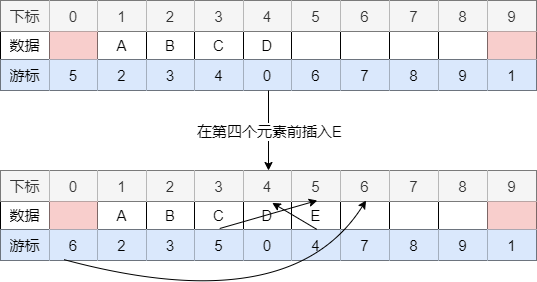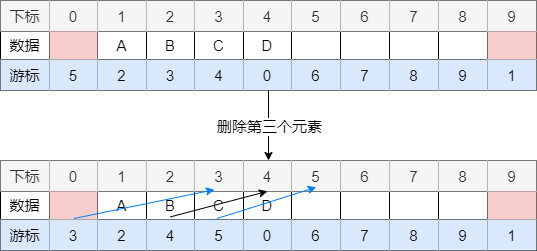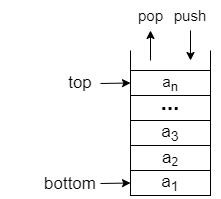静态链表
我们都知道C语言的强大在于其有指针可以直接操作内存,因此可以将链表完美的实现出来;但在C语言之前的一些语言并没有指针,于是他们就想出了静态链表。
所谓的静态链表就是指用数组来描述链表,这也称作游标实现法。
原理

以静态单链表举例,我们用数组存储数据,通过游标来模拟指针。每一个数组元素的游标用来存放其直接后继结点的下标,这样就组成了链表。
和之前一样表的0位不放数据用做特殊用途,同时数组的最后一位也不放数据用做特殊用途。
存放数据的数组元素按顺序组成和上篇类似的单链表,并将链表1号结点的下标放到数组最后一位的游标里,也就是说数组最后一位元素相当于链表的头结点;而对于那些未使用的数组元素,我们也将其链起来,称为备用链表,备用链表的首个结点的下标放到数组0位的游标里。
实现
构建结点
/* C语言要加这些,C++不用 */
#include <stdbool.h>
typedef struct Node Node;
typedef int Elem_Type;
#define MAX_SIZE 20
struct Node // 结点
{
Elem_Type data; // 数据域
int cursor; // 指针域
} list[MAX_SIZE]; // 声明头指针
typedef struct Node Static_Link_List; // 方便区分代码中使用链表初始化和清空
因为是通过数组来描述链表,因此初始化和清空操作一样:清空数据域,串联备用链表,将数组的最后一位的指针域指向数组的0位。
void init_list(Static_Link_List list[])
{
for(int i=0 ; i<MAX_SIZE-1 ; i++) // 全是备用链表
{
list[i].data = 0;
list[i].cursor = i+1;
}
/* 表明空表 */
list[MAX_SIZE-1].data = 0;
list[MAX_SIZE-1].cursor = 0;
}
void clear_list(Static_Link_List list[])
{
init_list(list);
}判空
数组的最后一位的指针域是否指向数组的0位。
bool list_is_empty(Static_Link_List list[])
{
if (list[MAX_SIZE-1].cursor == 0)
{
return true;
}
return false;
}获取表长
遍历链表获取表长。
int list_length(Static_Link_List list[])
{
int count = 0; // 计数
int temp = list[MAX_SIZE-1].cursor; // 下标模拟指针
/* 遍历计数 */
while(temp != 0)
{
count++;
temp = list[temp].cursor;
}
return count;
}按值查找
按值查找是采用遍历的方式,因此时间复杂度还是O(n)。
int list_locate_elem(Static_Link_List list[],Elem_Type e)
{
int temp = list[MAX_SIZE-1].cursor; // 下标模拟指针
int count = 0;
/* 定位遍历 */
while(temp != 0)
{
count++;
if(list[temp].data == e) // 找到目标
{
return count;
}
temp = list[temp].cursor;
}
return 0;
}按位查找并获取
虽然这是数组来描述的,但按位查找也要遍历,因此时间复杂度同样为O(n)。
bool list_get_elem(Static_Link_List list[],int i,Elem_Type *e)
{
int count = 1;
int temp = list[MAX_SIZE-1].cursor; // 下标模拟指针
/* 定位遍历 */
while(temp!=0 && count<i)
{
temp = list[temp].cursor;
count++;
}
/* 定位失败 */
if(temp==0 || count>i) // 没找到元素或传入的i<1
{
return false;
}
*e = list[temp].data;
return true;
}插入
插入操作分两大步:
- 从备用链表中取出空的结点,模仿动态链表的申请空间。
- 实现插入,参考动态链表的插入操作

bool list_insert(Static_Link_List list[],int i,Elem_Type e)
{
int count = 1;
int temp = MAX_SIZE-1; // 要插入的前一个结点
/* i错误,空间不足 */
if(count>i || list[0].cursor==MAX_SIZE-1) // 传入的i<1或无空间插入
{
return false;
}
/* 定位遍历 */
while(temp!=0 && count<i)
{
temp = list[temp].cursor;
count++;
}
/* 定位失败 */
if(temp==0) // 没找到元素
{
return false;
}
/* 插入 */
list[list[0].cursor].cursor = list[temp].cursor; // 尾部连接
list[temp].cursor = list[0].cursor; // 头部连接
list[list[0].cursor].data = e; // 填入数据
list[0].cursor = list[list[0].cursor].cursor; // 从备用链表中删除
return true;
}删除
同插入操作,所有删除也分两大步:
- 找到该结点并从链表中删除,与动态链表的删除同理
- 将删掉的结点放入备用链表,类似释放空间

bool list_delete(Static_Link_List list[],int i,Elem_Type *e)
{
int count = 1;
int temp = MAX_SIZE-1; // 要删除的上一结点的下标
int delete_node = NULL; // 要删除的结点的下标
/* 定位遍历 */
while(temp!=0 && count<i)
{
count++;
temp = list[temp].cursor;
}
/* 定位失败 */
if(temp==0 || count>i) // 没找到元素或传入的i<1
{
return false;
}
/* 找到要删的结点并取出数据 */
delete_node = list[temp].cursor;
*e =list[delete_node].data;
/* 从链表中删除 */
list[temp].cursor = list[delete_node].cursor;
/* 加入备用链表 */
list[delete_node].cursor = list[0].cursor;
list[0].cursor = delete_node;
return true;
}头插法
/* 方法一 */
void list_push_front(Static_Link_List list[],Elem_Type e)
{
int push_node = list[0].cursor; // 要插入的
list[push_node].data = e;
/* 从备用链表中取出 */
list[0].cursor = list[push_node].cursor;
/* 插入链表 */
list[push_node].cursor = list[MAX_SIZE-1].cursor;
list[MAX_SIZE-1].cursor = push_node;
}
/* 方法二 */
void list_push_front(Static_Link_List list[],Elem_Type e)
{
list_insert(list,1,e);
}尾插法
/* 方法一 */
void list_push_back(Static_Link_List list[],Elem_Type e)
{
int temp = MAX_SIZE-1; // 找到最后一个结点
int push_node = list[0].cursor; // 要插入的
list[push_node].data = e;
/* 从备用链表中取出 */
list[0].cursor = list[push_node].cursor;
/* 插入链表 */
while(list[temp].cursor != 0)
{
temp = list[temp].cursor;
}
list[temp].cursor = push_node;
list[push_node].cursor = 0;
}
/* 方法二 */
void list_push_back(Static_Link_List list[],Elem_Type e)
{
list_insert(list,list_length(list)+1,e);
}其他部分
void create_10elem_list(Static_Link_List list[])
{
for(int i=10 ; i>0 ; i--)
{
list_push_front(list,i); // 头插法插入10个元素
}
}
void print_list(Static_Link_List list[])
{
int temp = list[MAX_SIZE-1].cursor;
while(temp != 0)
{
if(sizeof(Elem_Type) == 4)
{
printf("%d ",list[temp].data);
}
temp = list[temp].cursor;
}
printf("\n");
}优缺点
我们将静态链表看作链表的一种,所以将其与数组这类顺序存储结构的线性表作比较。
优点
- 在多元素插入和删除的操作时不需要移动大量元素,只要修改游标即可。
缺点
- 连续的内存分配,无法解决表长无法确定的问题
- 没有随机存取的特性










